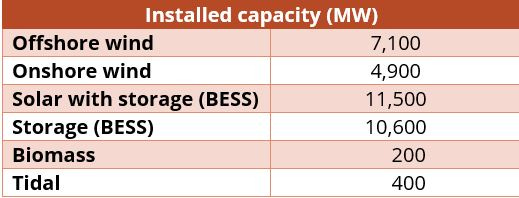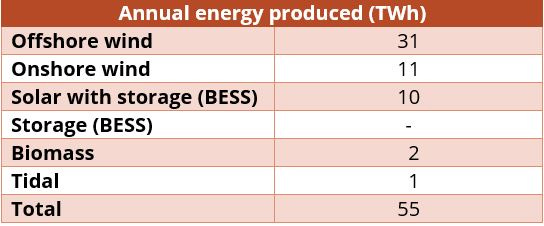The TEC Register is a list of projects that holds contracts for Transmission Entry Capacity (TEC) with the National Energy System Operator (NESO). These include existing and future connection projects and projects that can be directly connected to or use the National Electricity Transmission System (NETS).

Following Ofgem’s decision on 15 January 2025, NESO will introduce a pause in applications, subject to exceptions outlined in Ofgem’s decision letter. More info on this can be found here.
Dr Jonathan F Dean, CPRW Trustee, has examined the register and provided an overview of the Welsh content before the reassessment.
If, like me, you find yourself overwhelmed by big numbers and what they mean, here is a rough calculation.
For his full appraisal, read on ……
It cannot have escaped many that the Welsh and U.K. Governments’ drive to achieve net zero has produced a “gold rush” of proposals from developers keen to get in on the action whilst the legislative environment is supportive and commercial opportunities still exist. This is particularly so in Wales, where there has never been a de facto ban on onshore wind turbines as there was, until recently, in England. This begs the question;
How many proposals are there currently?
How much electricity will they produce?
How much more might be needed?
Examining the National Energy System Operator (NESO) database gives us a glimpse of what might soon be on our hilltops and fields.
Until recently, NESO was a part of National Grid plc and is the body that operates the electricity system. They agree on who can connect to the grid when those generators are required to produce and balance the supply of electricity day by day, hour by hour and minute by minute, such that supply always meets demand. In 2024, at the request of Ofgem, the market regulator, they were separated from National Grid plc and are now a stand-alone, state-owned company.
Wales already generates about half of all electricity used in Wales1 from renewables, with the main sources being;
However, far more electricity is still produced from fossil fuels at three main gas power stations.
It is mainly due to these gas power stations that, overall, Wales generates twice the amount of electricity we consume. For the U.K. Government to achieve the Clean Power 2030 objective, the operation of these gas stations will have to be significantly reduced.
Long before a developer applies for consent to build a wind or solar farm, they apply to NESO for a connection agreement. By law, NESO has to grant an agreement, but exactly where or when the connection can be made is down to the transmission and/or distribution companies. In Wales, these are National Grid Electricity Transmission (NGET), National Grid Electricity Distribution (NGED) in the south and Scottish Power Energy Networks (SPEN) in the north. All connections to the transmission system, or which will have an impact on it, are recorded in the Transmission Entry Capacity Register (TEC Register), which is available online for anyone to access.2
As of the end of January, there were a total of 149 agreements in place, recorded in the TEC Register, for new generating capacity, not yet built, to supply the grid.3
Many small developments will also connect directly to the distribution systems without impacting the transmission system, so this snapshot is less than the total.
In addition to this, there is also:
3,600 MW capacity connecting to Connah’s Quay of hydrogen/CCGT as demand/generation, and it is not clear if the stated capacity I’d demand from the grid to produce hydrogen or supply to the grid from burning hydrogen
almost 1,000 MW capacity of nuclear at Trawsfynydd, although this site is no longer being considered for new nuclear, possibly due to grid and site constraints in north Wales
600 MW of hydrogen/BESS connecting to Wylfa as demand/generation. This could be as either demand from or supply to the grid
There is no guarantee that all these connection agreements and developments will progress as far as submitting a planning application, let alone obtain consent and actually be built. However, in the current “gold rush” climate, it is highly likely that they will, and if they do, could generate over 55 TWh of electricity a year.4
In Future Energy Scenarios 2024 (FES2024), NESO show that in 2050, when the whole of the U.K. has achieved net zero, Wales will be consuming 41 TWh per year of electricity,5 so the current “connection queue” already has 30% more capacity more than is necessary for net zero.
However, FES2024 also shows that Wales will be generating 71 TWh per year, as Wales will remain a net exporter of electricity to the rest of GB. A further 12 GW of capacity is anticipated in the Celtic Sea, and an undisclosed additional capacity can be anticipated in the Irish Sea. The TEC Register already includes over 20 GW of capacity connecting into Devon. If only half of the 12 GW was classed as “Welsh generation”, that would add an extra 26 TWh, giving a total of 81 TWh, well in excess of the NESO estimates.
The UK government has published a Clean Power Action Plan,6 which includes estimates for onshore wind, solar, and battery storage by region of GB (England & Wales and Scotland). A breakdown between England and Wales is not given, but it includes the anticipated installed capacity by 2030.
The connection queue in the TEC Register shows that Wales already has connection agreements in place for about a quarter of the England and Wales solar allocation and over half the battery storage
Discussion and conclusions
As has been said many times before, Wales has more than enough offshore wind potential to generate sufficient electricity to achieve net zero as a nation by 2050 and continue exporting electricity to other parts of GB. Onshore wind is not needed at all for net zero or to keep the lights on and remains less popular with the U.K. public than offshore wind.7
However, as progress with offshore wind in Wales is painfully slow, unlike in England and Scotland, this is unlikely to come online to contribute to the U.K. Government’s Clean Power 2030 aspiration. Onshore wind is thus being used to “fill the gap” with Wales, providing over half of the generation of England and Wales. Wales is “ahead” in the onshore renewables race due to the de facto ban that was in place in England.
It could be argued that Wales is being exploited for onshore wind, and offshore wind is being deliberately held back, but this risks vanishing down political conspiracy rabbit holes, where there is little chance of a concrete conclusion.
The level of solar and battery storage being planned appears grossly excessive compared to the levels required by the Clean Power Action Plan, and solar is likewise not required at all for net zero, only to achieve the 2030 target.
Whether by accident or design, Wales would seem to be doing a disproportionate amount of the heavy lifting to decarbonise England.
As the transmission grid in Wales is just a small part of the interconnected grid across the whole of GB, and Wales will be a net exporter as a nation, there is no need for any generation other than offshore wind. The demand estimates include the production of hydrogen for balancing and any storage losses. Wales does not need nuclear due to the wealth of renewables. However, there may be a case for specific industrial applications or if waste heat were being used for industrial or domestic heat networks.
Footnotes
See Energy Generation in Wales (2022)
https://www.gov.wales/sites/default/files/publications/2023-11/energy-generation-in-wales-2022.pdf
The available data has been “lightly cleansed” to remove obvious rouge data records and includes generators in Wales that will connect to the grid in England.
For the estimate of total annual generation, the following approximate capacity factors have been assumed: offshore wind 50%, onshore wind 25%, solar 10%, biomass 85%, and tidal 25%. Although BESS are classed as generators, like pumped hydro, they are not net generators but storage systems
See Figure ES-02, page 100 of Future Energy Scenarios 2024
Future Energy Scenarios (FES) | National Energy System Operator









" ...there is no need for any generation other than offshore wind."
Except when it's not windy.
Much of these proposals are illogical and should never be built.
Hydrogen (It will have to be green) is a very expensive fuel, and even if it is made with reformed methane (The reason for CCS?) is wasteful and inefficient. Carbon Capture and Storage is another really impractical and expensive process and requires significant amounts of power from the generator.
The Welsh government, like the U.K. government is driven by idealism with no real understanding of the technicalities and disadvantages of renewable generation (And like the Scottish try to out do the U.K. with even more ambitious and ruinous plans). The significant one is the amount of grid expansion required, which if we had a sensible electrical system are not needed.
Trawsfynydd caught my eye, as I worked there when it was active. It was rated at 500 Mwatts so the talk of 1000 Megawatts is puzzling as the drid connection would not cope with that? It makes sense to use old sites a sthe grid connection exists but not if it has to be uprated? And why rule out nuclear?
Our grid is slowly and inexorably getting worse and less reliable. We had anear miss early in January and a trip of some generator or transformer could have put it over the edge. Trips cannot be forseen so that is the risk with reduced inertia and running very close to capacity.